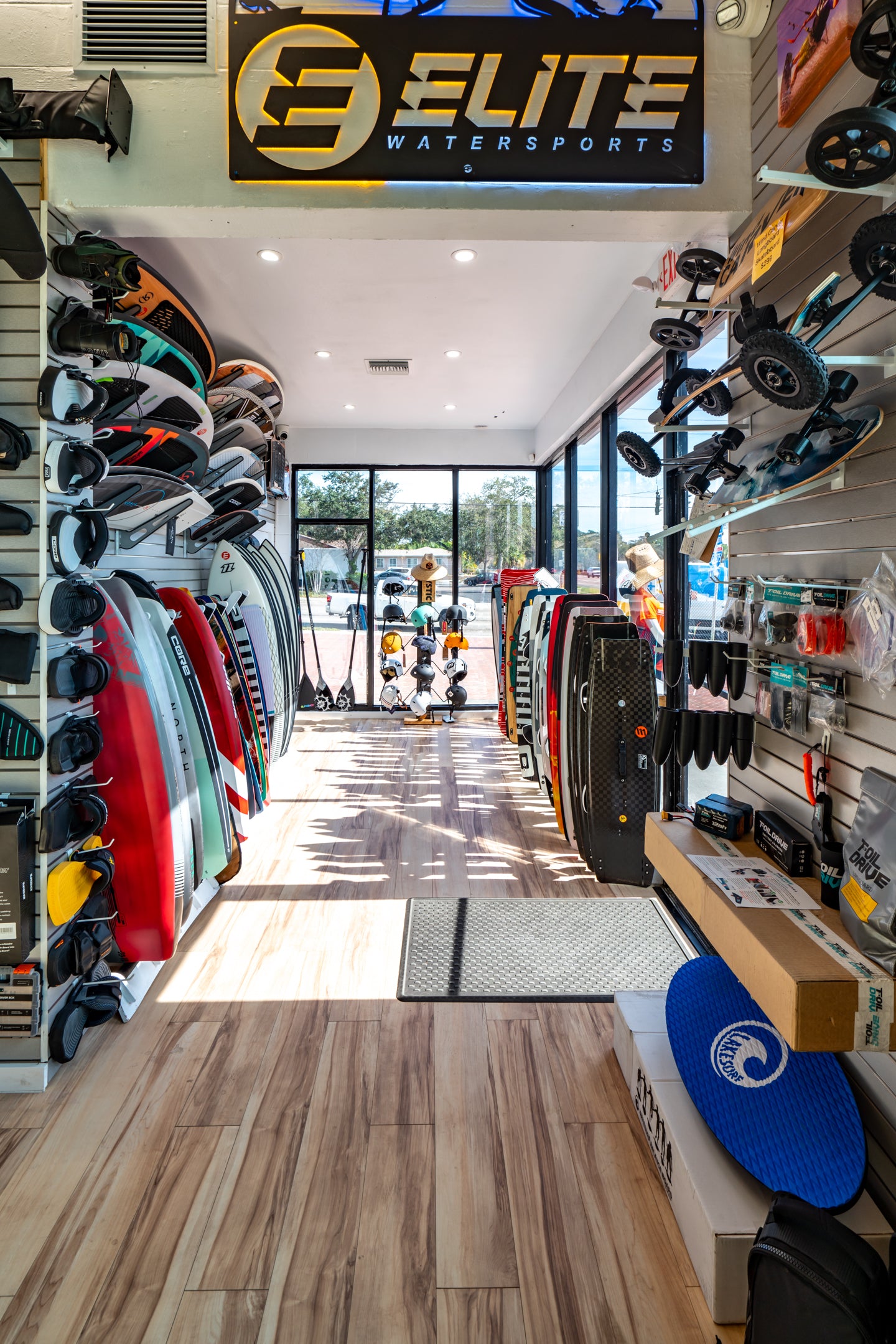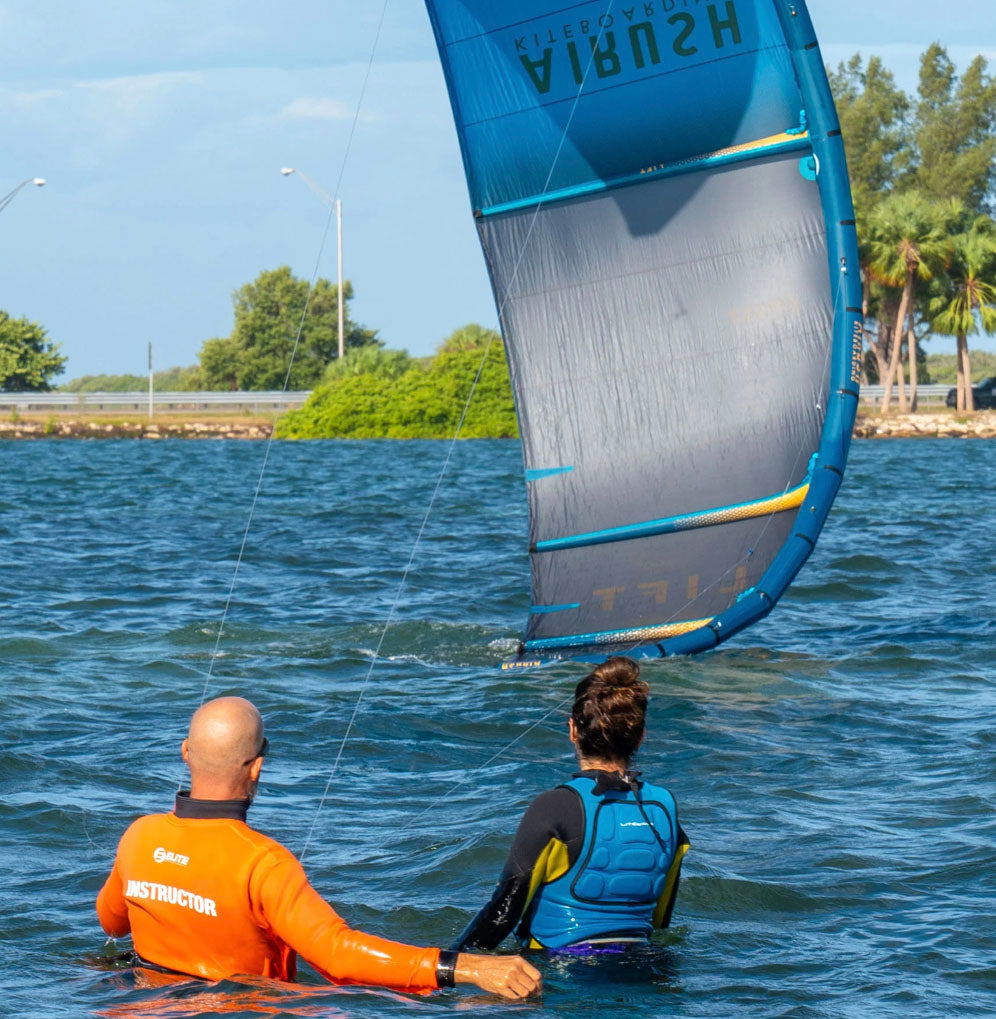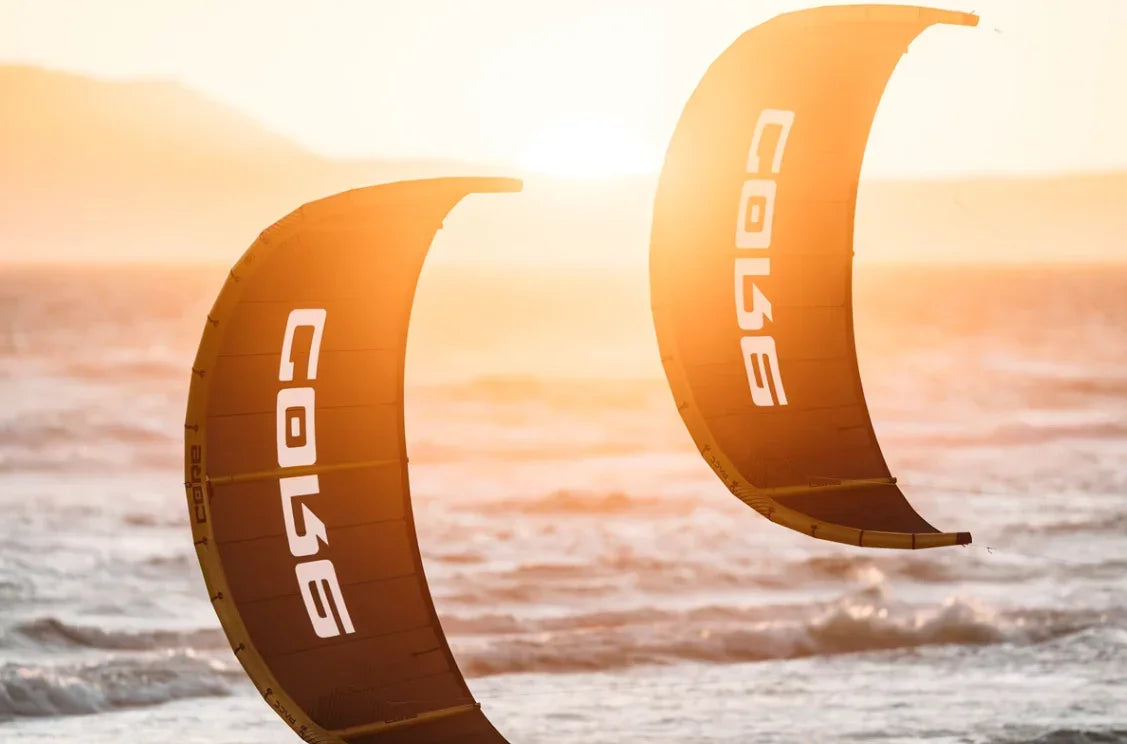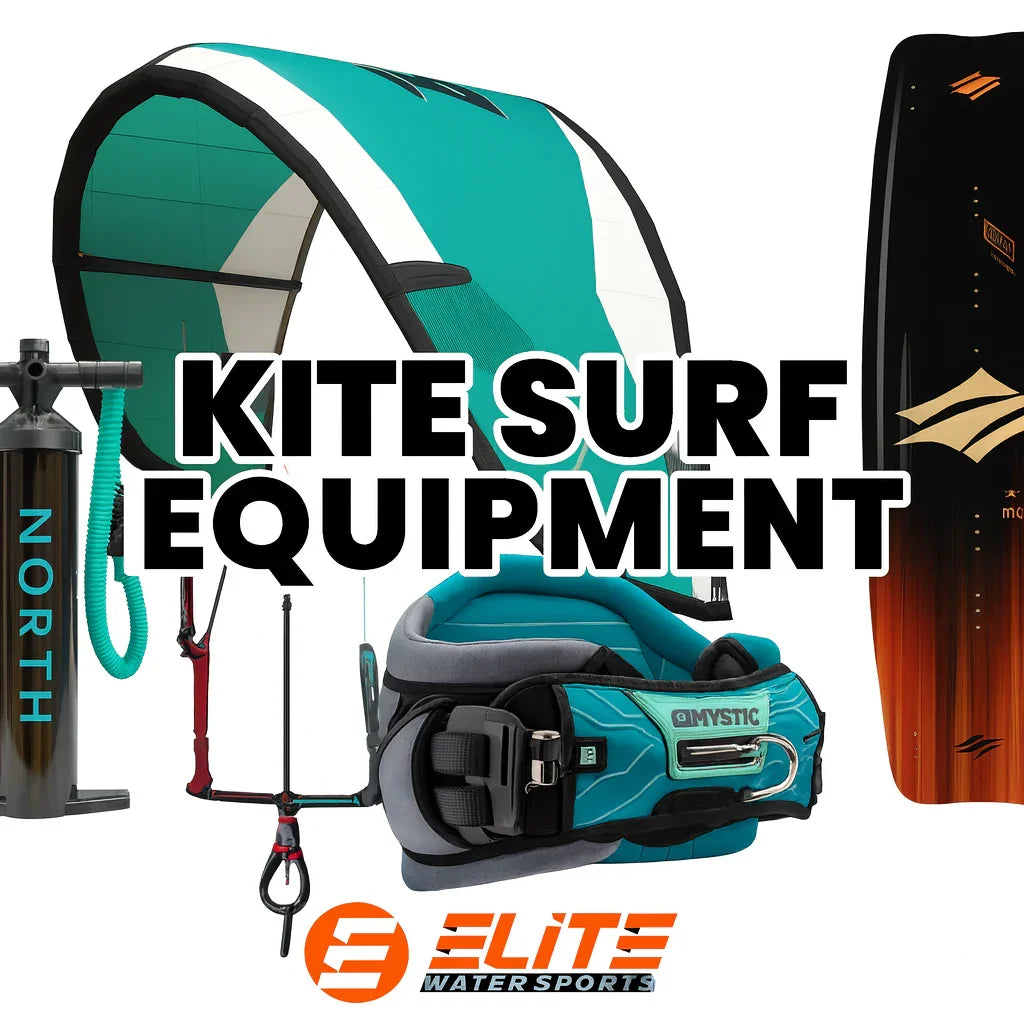ELITE WATERSPORTS
Last updated 3-03-2025
When Do You Actually Need a Drysuit for Kiteboarding?
Everything you need to know kiteboarding here.

Do You Need A Drysuit?
If you’re a kiteboarder in St. Petersburg, Tampa Bay, or anywhere along Florida’s Gulf Coast, you’ve probably wondered: Do I really need a drysuit, or is my wetsuit enough?
Drysuits aren’t just for icy waters—they can be a game-changer for cold wind conditions, extended water time, and staying comfortable year-round. But they’re not the same as wetsuits, and if you don’t layer correctly, you could end up colder than expected.
In this guide, Aaron from Elite Watersports in St. Pete shares first-hand insights from years of teaching and riding in the Prolimit Nordic Drysuit. We’ll cover:
- When to wear a drysuit vs. a wetsuit (Hint: Florida riders might be surprised)
- How a drysuit works & what to wear underneath
- The key features of the Prolimit Nordic Drysuit and why it’s a favorite
- How to keep your drysuit in top shape for seasons of use
By the end, you’ll know exactly whether a drysuit is worth it for your kiteboarding sessions.


Table Of Contents
- What is a Drysuit & How Does It Work?
- Drysuit vs. Wetsuit: What’s the Difference?
- When Should You Wear a Drysuit for Kiteboarding & Watersports?
- How to Maintain a Drysuit (So It Lasts for Years)
- FAQs About Using a Drysuit for Kiteboarding
What is a Drysuit & How Does It Work?
Ever wondered how some riders stay out longer while you’re shivering and calling it quits? That’s the magic of a drysuit—your built-in shield against cold water and biting wind.
Unlike a wetsuit, which lets a little water in to warm up against your skin, a drysuit says, “Not today, ocean,” and keeps every drop of water out. Think of it as a windproof, waterproof force field—but one that still lets you move freely.
How It Works:
- 100% Waterproof Material – Keeps you bone dry, even after a wipeout.
- Loose Fit – Gives you room to layer up, so your warmth depends on what you wear underneath.
- Sealed Neck, Wrists & Ankles – Locks water out, because surprise cold splashes are never fun.


Aaron’s Take: “A drysuit doesn’t magically heat you up—it just keeps you dry. The warmth comes from what you wear underneath. Dress like you’re hanging out on the beach, not like you’re jumping in the water.”
One of the best options out there? The Prolimit Nordic Drysuit—a lightweight, ultra-flexible drysuit that won’t make you feel like you’re wearing a space suit. Plus, the front zipper means no awkward struggling to get in and out of it.So, if you’re tired of cutting your sessions short while your friends keep riding, it might be time to gear up with a drysuit.
Drysuit vs. Wetsuit: What’s the Difference?
So, do you really need a drysuit, or will a wetsuit do the trick? The biggest difference is simple:
- Wetsuits let in a little water and use your body heat to warm it up.
- Drysuits keep all water out, and your warmth depends on what you wear underneath.
Both have their place, but choosing the right one depends on where, when, and how long you’re riding.


Aaron’s Take: "I love wetsuits for most Florida sessions, but when the wind chill is high or I’m out all day teaching, I’m in a drysuit. There’s nothing better than peeling it off and being completely dry underneath."
If you’re not sure whether a wetsuit will be warm enough, check out our guide on the different wetsuit styles and how they perform in different conditions:
👉 Kiteboarding Wetsuits: Front Zip vs. Back Zip vs. Zipless
When Should You Wear a Drysuit for Kiteboarding & Watersports?
You might think drysuits are only for extreme cold-water riders, but they’re actually useful in more conditions than you’d expect. Even in Florida, where the water stays warmer than most places, there are plenty of times when a drysuit makes sense.
1. Cold Wind Days (Even in Florida!)
Water temperature isn’t the only thing that makes you cold—wind chill is real. When the wind picks up, even a mild winter session in Tampa Bay can turn into a teeth-chattering experience. A drysuit blocks that icy wind completely, keeping you warm without the soaked, soggy feeling of a wetsuit.
Aaron’s Take: “People always joke, ‘You’re in Florida, why do you need a drysuit?’ But trust me, when that north wind kicks in, you’ll wish you had one.”
2. Long Sessions & Back-to-Back Riding
If you love staying on the water for hours at a time, a drysuit keeps you comfortable and dry the entire session. Plus, you can peel it off and be ready to grab food or head home—no need to change out of a cold, damp wetsuit in a parking lot.
3. Teaching, Rescuing, or Boat Support
If you're teaching lessons, riding jet skis, or assisting riders from a boat, a drysuit is a no-brainer. You’re in and out of the water constantly, and staying warm means staying sharp—which is especially important when you're responsible for others.
4. Post-Session Comfort & Convenience
Let’s be honest: standing in a windy parking lot, shivering while peeling off a wet, cold wetsuit is the worst. With a drysuit, you can step right out of it and be completely dry underneath—no need to rush home for a hot shower.
5. When the Water Actually Gets Cold (Yes, Even Here!)
While Florida doesn’t have icy conditions, winter water temps can dip lower than you’d expect—especially in shallow riding spots like Tampa Bay, St. Pete, and Fort De Soto. A drysuit extends your season so you can ride comfortably even when others pack it up for winter.


How to Choose the Right Drysuit for Kiteboarding & Foiling
Not all drysuits are created equal. If you’re investing in one, you’ll want to make sure it’s built for mobility, durability, and all-day comfort—especially for an active sport like kiteboarding.
What to Look for in a Kiteboarding Drysuit
- Flexibility & Range of Motion – You need a suit that moves with you, not one that makes you feel like you’re wrapped in a tarp.
- Waterproof Zipper Placement – A front-zip drysuit is easiest to get in and out of solo (no awkward struggles in the parking lot).
- Breathable, Lightweight Material – Avoid stiff or bulky suits; modern drysuits are designed to feel natural and non-restrictive.
- Sealed Neck, Wrist & Ankle Gaskets – This is what keeps you 100% dry, so a good seal is non-negotiable.
Why We Recommend the Prolimit Nordic Drysuit
The Prolimit Nordic Drysuit is a top choice among Florida riders because it’s:
✅ Super Flexible – Doesn’t feel stiff or bulky like some drysuits.
✅ Front-Zip Design – Easy to put on and take off by yourself.
✅ Durable & Waterproof – Keeps you completely dry, even after hard crashes.
✅ Comfortable for Long Sessions – No overheating, no awkward fit—just warm, dry riding.
Aaron’s Take:
"The biggest mistake I see is people buying a drysuit that’s too stiff. The Nordic is my go-to because it lets me move naturally while keeping me dry all day."
💬 Still not sure if a drysuit is right for you? Stop by Elite Watersports in St. Pete or contact us—our team is happy to help you find the perfect gear for your riding style!
How to Maintain a Drysuit (So It Lasts for Years)
A good drysuit is an investment, and with proper care, it can last multiple seasons without leaks or failures. Here are the three biggest things to focus on:
1. Keep the Zipper in Top Shape
The waterproof zipper is the most important part of your drysuit—if it fails, your suit isn’t dry anymore!
- Always fully close the zipper before getting in the water. Even a small gap can let water in.
- Use zipper lubricant (like the one included with the Prolimit Nordic Drysuit) to keep it moving smoothly.
- Never force the zipper—if it sticks, stop and apply lubricant instead of yanking it.
2. Rinse & Dry It Properly
Salt, sand, and dirt can wear down the material and seals over time, so give your drysuit some post-session love.
- Rinse with fresh water after every use, especially around the seals and zipper.
- Hang it inside out first to dry completely, then flip it back to dry the outer layer.
- Store it unzipped and laid flat (not crumpled in a bag) to avoid creases that weaken the material.
3. Check Your Seals for Wear & Tear
The neck, wrist, and ankle gaskets keep water out, but they can crack or loosen over time.
- Check for small cracks or signs of wear every few sessions.
- Avoid stretching the seals too aggressively when putting the suit on or off.
- If a seal starts leaking, get it replaced early—a small fix now prevents a ruined session later.
FAQs About Using a Drysuit for Kiteboarding
Drysuits are simple in concept, but if you’ve never worn one before, you probably have some questions. Here are the most common ones we hear:
1. Do drysuits keep you warm without layers?
Nope! A drysuit only keeps water out—it doesn’t provide insulation. Your warmth comes from what you wear underneath, so layering correctly is key. Think thermal base layers or fleece for colder days.
Aaron’s Take: “People always joke, ‘You’re in Florida, why do you need a drysuit?’ But trust me, when that north wind kicks in, you’ll wish you had one.”
2. Can you swim in a drysuit?
Technically, yes—but it’s not ideal. Drysuits are designed for staying on top of the water, not in it. If water gets inside through the neck or wrist seals, it won’t drain like a wetsuit.
3. How do you prevent water from leaking in?
- Make sure the seals around your neck, wrists, and ankles are snug but not uncomfortably tight.
- Close the zipper completely—even a small gap can let water in.
- Check for gasket wear regularly and replace them when needed.
4. Can I wear my regular clothes under a drysuit?
Yes, but avoid cotton—it soaks up moisture and won’t keep you warm. Stick with moisture-wicking layers like fleece or synthetic thermals.
5. How long does a drysuit last?
With proper care, a high-quality drysuit like the Prolimit Nordic Drysuit can last several seasons. The key is rinsing it after each use, maintaining the zipper, and checking the seals regularly.
Is It Time to Add a Drysuit to Your Gear?
So, is a drysuit the right choice for you? If you’re kiting in Florida’s winter winds, spending long hours on the water, or just prefer to stay completely dry, a drysuit is a game-changer.

You Should Consider a Drysuit If…
- You ride in cold wind conditions – Even in Florida, strong north winds can make sessions feel freezing.
- You stay on the water for hours – Teaching, foiling, or doing back-to-back sessions? Staying dry keeps you comfortable longer.
- You want to skip the post-session chill – No more shivering in a parking lot while peeling off a soggy wetsuit.
- You ride all winter – If you refuse to let a little cold stop you, a drysuit extends your season effortlessly.
For riders in St. Pete, Tampa Bay, and Florida’s Gulf Coast, the Prolimit Nordic Drysuit is one of the best options out there—flexible, lightweight, and designed for high-movement sports like kiteboarding.
💬 Still unsure? Stop by Elite Watersports in St. Pete, call us, or send a message—we’ll help you decide if a drysuit is the right fit for your riding style!
🔗 Want to complete your cold-weather setup? Check out our kiteboarding accessories guide for gloves, booties, and other must-haves.
Why you should take Kiteboarding Lessons with Elite Watersports.
Elite Watersports has served the Tampa and St Petersburg area for years. They offer kiteboarding and wingsurfing lessons. They also have a retail shop equipt with the latest kitesurfing gear. This is hands down the best location to learn kitesurfing. We have shallow flat water and easy beginner conditions. Call today and reserve your spot for jet-ski-supported lessons. If the wind is blowing, we're going!
If you need help give us a call. .
(727)-800-2202


Author

Ryan "Rygo" Goloversic
Rygo is a globally recognized kiteboarder, digital marketing expert and an advocate for wakestyle kiteboarding. When he's not writing articles, you can catch him competing on the KPLxGKA world tour or grinding it out in the gym.
Tags
Kiteboarding Florida Beaches
You May Also Like
Want To learn more about kiteboarding?
Follow us to receive the latest update on our journey experience




